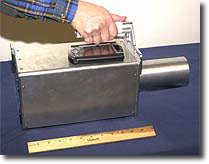WMD detection technologies must balance security with civil liberties
LIVERMORE, Calif. — New technologies to combat threats from weapons of mass destruction (WMDs) should not be developed in a legal vacuum.
This contention is advanced by Don Prosnitz, the deputy director of Lawrence Livermore National Laboratory’s Homeland Security Organization, in an article that appears today in the journal Science .
“Balancing security and civil liberties is a shared burden, ” Prosnitz said. “Courts, legislatures (and the citizens they represent) and the technical community must all participate. Scientists and engineers who are aware of limitations on search and seizure in the U.S. Constitution can help ensure that the technical community’s efforts will be maximally useful.”
During the summer of 2001, the U.S. Supreme Court in Kyllo v. United States held that law enforcement’s viewing of a private residence, without a search warrant, with an infrared camera was unconstitutional based on the Fourth Amendment prohibition against unreasonable search and seizure.
Three months later, the September 11 terrorist attacks occurred, followed the next month by the mailing of letters with anthrax spores to members of Congress.
In subsequent weeks, the nation’s scientific and technical community was mobilized to design and deploy advanced sensors – not in general public use – capable of detecting WMDs.
As Prosnitz noted, however, “virtually all operational scenarios for detecting WMDs preclude obtaining either prior consent for a search or a warrant.” So, given the Kyllo decision, how can searching for WMDs be made compatible with the Fourth Amendment?
Although developers of WMD detectors cannot anticipate future court decisions, in Prosnitz’s view they can apply four criteria to address traditional constitutional limits.
One critical criterion is sensor discretion, under which a nonintrusive sensor would only disclose contraband. Second, the instrument’s performance needs to be well documented. Third, the sensor clearly must be effective. And fourth, the sensors need to be readily available.
Prosnitz noted that all of these criteria can be addressed in the technology development process. For example, information barriers can be used to allow sensors to detect items of interest without revealing “private” details.
Sensor effectiveness can be demonstrated in progressively challenging environments, from experiments through test beds and pilot deployments.
With awareness of the role of the Fourth Amendment, Prosnitz said scientists and engineers can develop new sensing systems that give law enforcement the critical information it needs without infringing on civil liberties.
Founded in 1952, Lawrence Livermore National Laboratory has a mission to ensure national security and apply science and technology to the important issues of our time. Lawrence Livermore National Laboratory is managed by the University of California for the U.S. Department of Energy’s National Nuclear Security Administration.
Contact
Steve Wampler[email protected]
925-423-3107
Related Links
View in QuickTime formatView in Windows Media format
“WMD Sensors – Search and Seizure”
LLNL’s Homeland Security Organization
“Radiation Detection on the Front Lines”







